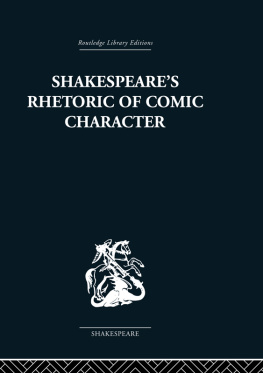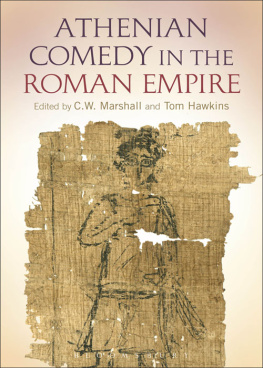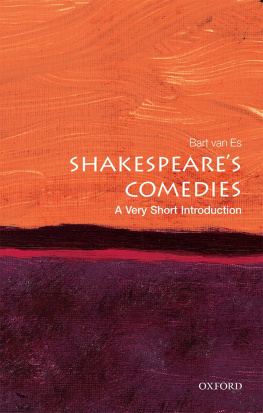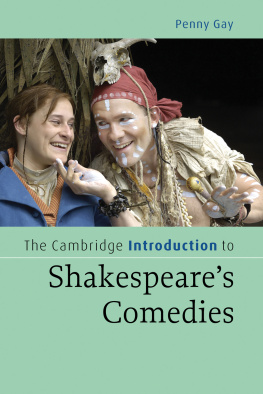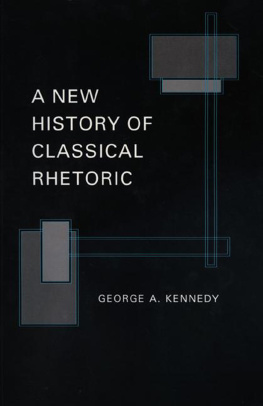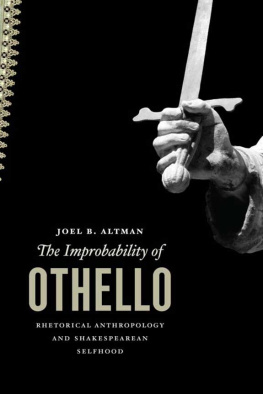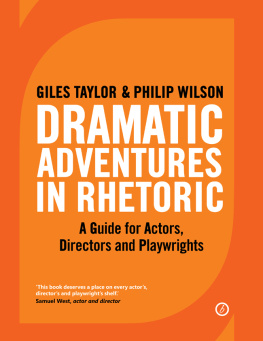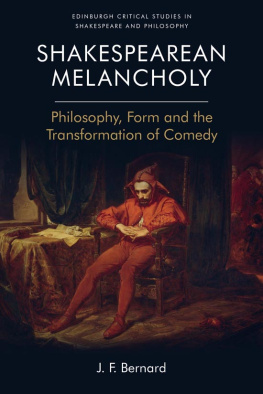Routledge Library Editions
SHAKESPEARES RHETORIC
OF COMIC CHARACTER

SHAKESPEARE
Routledge Library Editions Shakespeare
COMEDIES
In 6 Volumes
I | Shakespeare and his Comedies | Brown |
II | Shakespearian Comedy | Charlton |
III | Shakespeares Comedy of Love | Leggatt |
IV | Shakespeares Sources | Muir |
V | Comic Transformations in Shakespeare | Nevo |
VI | Shakespeares Rhetoric of Comic Character | Newman |
SHAKESPEARES RHETORIC
OF COMIC CHARACTER
Dramatic Convention
in Classical and
Renaissance Comedy
KAREN NEWMAN

First published in 1985
Reprinted in 2005 by
Routledge
2 Park Square, Milton Park, Abingdon, Oxon, OX14 4RN
Transferred to Digital Printing 2008
Routledge is an imprint of the Taylor & Francis Group
1985 Karen Newman
All rights reserved. No part of this book may be reprinted or reproduced or utilized in any form or by any electronic, mechanical, or other means, now known or hereafter invented, including photocopying and recording, or in any information storage or retrieval system, without permission in writing from the publishers.
The publishers have made every effort to contact authors/copyright holders of the works reprinted in Routledge Library Editions Shakespeare. This has not been possible in every case, however, and we would welcome correspondence from those individuals/companies we have been unable to trace.
These reprints are taken from original copies of each book. In many cases the condition of these originals is not perfect. The publisher has gone to great lengths to ensure the quality of these reprints, but wishes to point out that certain characteristics of the original copies will, of necessity, be apparent in reprints thereof.
British Library Cataloguing in Publication Data
A CIP catalogue record for this book
is available from the British Library
Shakespeares Rhetoric of Comic Character
ISBN 0-415-35271-1
ISBN 0-415-33086-6 (set)
Miniset: Comedies
Series: Routledge Library Editions Shakespeare
Shakespeares
Rhetoric of
Comic Character
Dramatic convention in
Classical and Renaissance comedy
Karen Newman
Methuen | New York and London |
First published in 1985 by
Methuen Inc.
733 Third Avenue, New York
NY 10017
Published in Great Britain by
Methuen & Co.
11 New Fetter Lane,
London EC4P 4EE
1985 Karen Newman
Typeset by Activity Ltd, Salisbury, Wilts.
Printed in Great Britain
at the University Press, Cambridge
All rights reserved. No part of this book may be reprinted or reproduced or utilized in any form or by any electronic, mechanical or other means, now known or hereafter invented, including photocopying and recording, or in any information storage or retrieval system, without permission in writing from the publishers.
Library of Congress Cataloging in Publication Data
Newman, Karen,1949
Shakespeares rhetoric of comic character.
Bibliography: p.
Includes index.
1.Shakespeare, William, 15641616Comedies.
2.Comedy. I. Title.
PR2981.N48 1985 822.33 84-27183
ISBN 0-416-37990-7
British Library Cataloguing in Publication Data
Newman, Karen
Shakespeares rhetoric of comic character:
dramatic convention in classical and renaissance comedy.
1. Shakespeare, WilliamComedies I. Title
822.33 PR2981
ISBN 0-416-37990-7
for Tom
Contents
1 The inward springs:
Measure for Measure II, ii, 16287
6 And all their minds transfigurd:
Shakespeares early comedies
7 Magic versus time:
As You Like It and Twelfth Night
It is my pleasure to acknowledge the many debts and obligations this book owes to others. Thanks are due to Harvard University for the Mellon Faculty Fellowship (19801), and to Brown University for the Henry Merritt Wriston grant (Fall, 1981), which allowed me the leisure to refine my argument and most importantly, to write. My general dependence on past scholarship is indicated in the notes to my text, but more personal debts require acknowledgment separately. I have gathered untold benefits from Jonas Barish, whose example as both scholar and teacher first encouraged this study of Shakespeare. His reading of my manuscript at various stages has been invaluable both for its patience with my early confusions and its faith in the ultimate text. I am also grateful to Louise George Clubb who first introduced me to the richness of Italian Renaissance comedy and its relationships with Elizabethan drama; to W. S. Anderson, whose early course on Virgil prompted me to pursue the classics; to Barbara Lewalski and Walter Cohen who read my manuscript and made many attentive suggestions; to my colleagues at Brown who have provided enthusiastic intellectual support and good fellowship. Special thanks go to Steve Goodwin for his meticulous translations from the Greek, and to E. Walter Hop ton for his conscientious service in the final stages of preparing the typescript. I also owe a more general debt to Frangoise Cusin Jankowski, an early teacher and present friend.
And there are other kinds of debts: to my friends, Carol Cook and Betsy Fox Zimmerman, and to my husband, Thomas R. Brooks.
I have used the Arden editions of Shakespeares texts (London, Methuen); quotations from Menander, Plautus and Terence are from the Oxford Classical Texts, but typeface has been standardized. In addition, I have used the following editions and translations:
Donatus, Commentum Terentiy Lipsiae, 1905.
La Commedia degV Ingannati, ed. Florindo Cerreta, Firenze, 1980.
Bargagli Girolamo, La Pellegrina, ed. Florindo Cerreta, Firenze, 1971.
Clyomon and Clamydes, ed. Betty J. Littleton, The Hague, 1968.
The Rope and Other Plays, trans. E. F. Wading, New York, 1964, rpt. 1977.
The Pot of Gold and Other Plays, trans. E. F. Watling, New York, 1977.
The Comedies of Terence, trans. Frank O. Copley, Indianapolis, IN, 1976.
Five Italian Renaissance Comedies, ed. and trans. Bruce Penman, New York, 1978.
At least since Samuel Johnson commended Shakespeares characters for their naturalness and criticized his plots for their conventionality, audiences have remarked what seems a fundamental contradiction in Shakespeares comedy between character and convention. Why, we ask, in the midst of the wonderful coincidences and arbitrary improbabilities of plot, the inherited paradigms of classical and Italian comedy, do we leave the theatre or study assured that Shakespeares characters develop and change? And perhaps more importantly, is their development really antithetical to the conventions and devices of comic drama?
Character is required in drama because action requires agents. Contemporary theoretical work on character, though primarily directed at narrative, has seized upon this Aristotelean observation to repudiate the notion of character as an individual who changes or develops, with an inner life or psychology. Critics have explained character as agency or function subordinate to action and have devalued
Next page
